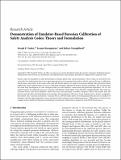Demonstration of Emulator-Based Bayesian Calibration of Safety Analysis Codes: Theory and Formulation
Author(s)
Buongiorno, Jacopo; Youngblood, Robert; Yurko, Joseph P
DownloadSTNI.2015.839249.pdf (1.429Mb)
PUBLISHER_CC
Publisher with Creative Commons License
Creative Commons Attribution
Terms of use
Metadata
Show full item recordAbstract
System codes for simulation of safety performance of nuclear plants may contain parameters whose values are not known very accurately. New information from tests or operating experience is incorporated into safety codes by a process known as calibration, which reduces uncertainty in the output of the code and thereby improves its support for decision-making. The work reported here implements several improvements on classic calibration techniques afforded by modern analysis techniques. The key innovation has come from development of code surrogate model (or code emulator) construction and prediction algorithms. Use of a fast emulator makes the calibration processes used here with Markov Chain Monte Carlo (MCMC) sampling feasible. This work uses Gaussian Process (GP) based emulators, which have been used previously to emulate computer codes in the nuclear field. The present work describes the formulation of an emulator that incorporates GPs into a factor analysis-type or pattern recognition-type model. This “function factorization” Gaussian Process (FFGP) model allows overcoming limitations present in standard GP emulators, thereby improving both accuracy and speed of the emulator-based calibration process. Calibration of a friction-factor example using a Method of Manufactured Solution is performed to illustrate key properties of the FFGP based process.
Date issued
2015Department
Massachusetts Institute of Technology. Department of Nuclear Science and EngineeringJournal
Science and Technology of Nuclear Installations
Publisher
Hindawi Publishing Corporation
Citation
Yurko, Joseph P., Jacopo Buongiorno, and Robert Youngblood. “Demonstration of Emulator-Based Bayesian Calibration of Safety Analysis Codes: Theory and Formulation.” Science and Technology of Nuclear Installations 2015 (2015): 1–17.
Version: Final published version
ISSN
1687-6075
1687-6083